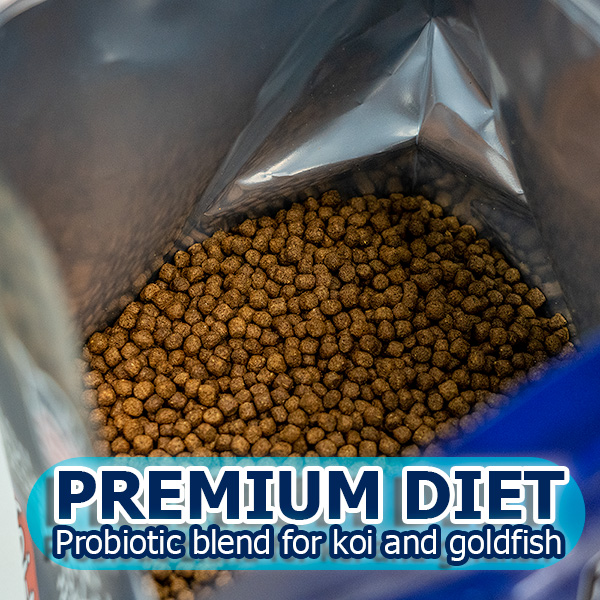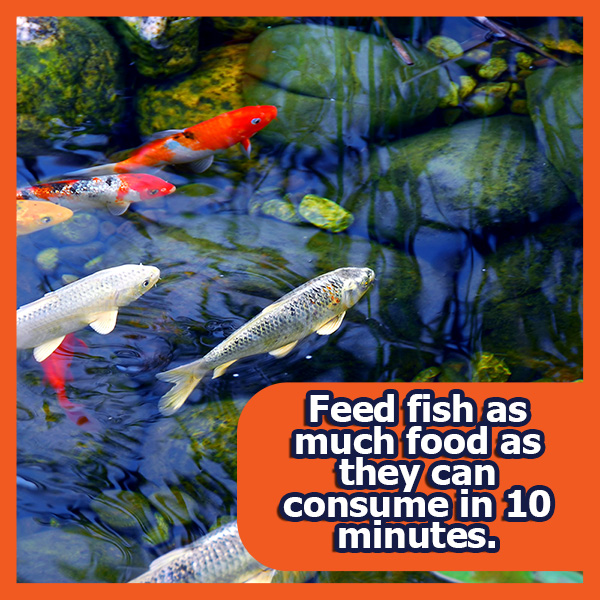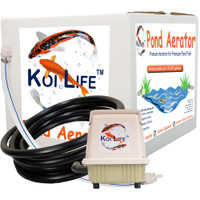
Pond Fish Food Probiotic Blend
Koi LifeProbiotic Fish Food for Koi & Goldfish
Koi Life Pond Fish Food Probiotic Blend is a floating pellet diet for koi and goldfish. This premium diet includes vitamins, micronutrients, and probiotics to maximize uptake of nutrients, improve digestion, and minimize waste.
The Ultimate Blend of Ingredients for Healthy Pond Fish- premium diet includes vitamins, micronutrients, and probiotics
-MAXIMIZE GROWTH of koi and goldfish with MINIMAL WASTE going back into water
-IMPROVES DIGESTION and NUTRIENT UPTAKE leading to healthier fish
-NO FILLERS used in this diet- over 60% of diet is premium fish meal and shrimp meal
ALL-SEASON Floating Koi Food, Goldfish Food

Fish Feeding Instructions
Feed to pond fish up to twice per day. Feed as much as your fish will consume in 10 minutes.

Guaranteed Analysis
Crude protein min: 40%
Crude fat min: 10%
Crude fiber max: 4%
Phosphorus min: 1%
Moisture max: 10%
Probiotic Microorganisms min 1,240,000 CFU/gram
Learn more about caring for koi and goldfish
Essential Guide to Koi Fish Nutrition and High-Quality Food
Koi fish are more than just beautiful pond decorations—they require careful attention to their diet to stay healthy and vibrant. A high-quality koi food balances protein, fats, vitamins, and minerals while avoiding harmful additives. This guide breaks down the science of koi nutrition into simple terms, highlighting what matters most when choosing food for your fish.
Protein is the most critical part of a koi’s diet. These fish need protein to grow, repair tissues, and maintain energy. Not all proteins are equal, though. Marine fish meal, made from ocean fish like anchovies or sardines, is one of the best sources because it’s packed with digestible protein that koi can easily absorb2. Studies show that marine fish meal can contain up to 75% protein, with 80–95% of it being usable by the fish2. Plant-based proteins, like soybean meal or corn gluten, are cheaper but harder for koi to digest28.
Koi also need specific amino acids, the "building blocks" of protein. Methionine, for example, is essential for growth and immune function. Research from Ohio State University found that koi fed diets lacking methionine grew slower and had weaker muscles5. High-quality foods often include animal-based proteins or supplements to meet these needs57.
Fats provide energy and help koi absorb vitamins. Omega-3 fatty acids, commonly found in fish oils, are especially important. These healthy fats reduce inflammation, support heart health, and enhance the fish’s natural colors14. For example, koi fed diets rich in omega-3s often develop brighter reds and deeper whites due to improved skin and scale health4.
However, too much fat can harm water quality. Excess fat floats on the pond’s surface, leading to oily residue and bacterial growth. Most experts recommend koi foods with 4–6% fat content to balance energy needs without compromising water clarity47.
Koi struggle to digest carbohydrates, so high-quality foods keep these ingredients minimal. Wheat germ is a common carbohydrate source in "cold weather" foods because it’s easier to break down when water temperatures drop below 50°F2. During warmer months, koi benefit from low-fiber diets that prioritize protein and fats2.
Overloading food with carbohydrates like corn or rice can lead to digestive issues and poor growth. A study from Bangladesh Agricultural University found that plant-based ingredients like rice polish had only 35% digestibility in koi, meaning most of it passes through unused8.
Vitamins and minerals might not be visible, but they’re vital for koi health:
-
: Strengthens bones and scales.
-
: Boosts immunity and protects against disease1.
-
: Heals wounds and reduces stress7.
High-quality foods often include added vitamins in "chelated" forms, which are easier for koi to absorb. For example, selenium supplements in fish feed have been shown to accelerate growth and improve survival rates in young koi4.
A koi’s color is a sign of its health. Premium foods use natural additives to enhance pigmentation:
-
: A blue-green algae rich in carotenoids, which intensify red and yellow hues47.
-
: A pigment found in shrimp and krill that deepens orange and red tones4.
-
: Adds brightness to white scales7.
Farmers raising show-quality koi often use feeds with 10–20% spirulina content to achieve award-winning colors47. Avoid synthetic dyes, as they can stress the fish and fade over time.
Low-quality feeds may contain heavy metals or toxins from cheap ingredients. A Purdue University study found that some fish feeds exceeded safe levels of lead, cadmium, and mercury—chemicals that accumulate in koi organs and shorten their lifespan6. Always choose foods from reputable brands that test for contaminants.
Koi’s dietary needs change with water temperature:
-
: Stop feeding. Koi can’t digest food in cold water2.
-
: Use wheat germ-based food 1–2 times weekly2.
-
: Switch to high-protein summer food, feeding 3–6 small meals daily2.
Overfeeding pollutes the water and risks obesity. A good rule is to offer only what your koi can eat in 5 minutes.
-
: Fresh koi food has a mild, ocean-like scent. Rancid or bitter smells indicate spoiled fats or low-quality ingredients7.
-
: Premium pellets float for 1–2 minutes, giving koi time to eat them before they sink.
-
: Look for specific protein sources like "whole herring meal" instead of vague terms like "fish products."
Summary
Choosing the right koi food isn’t just about price—it’s about understanding what’s inside the bag. Prioritize foods with marine proteins, natural color enhancers, and added vitamins. Avoid fillers like corn and soy, and always check for contamination reports. By investing in quality nutrition, you’ll ensure your koi live long, healthy lives while showcasing their most vibrant colors.
For more tips, consult local koi clubs or university aquaculture programs. They often provide free guides on fish care and nutrition278.
Citations:
- https://packer.hms.harvard.edu/7-koi-fish-benefits-must-see-nutrition-facts
- https://koiclubofsandiego.org/Feeding-&-Basic-Nutrition
- https://srac.msstate.edu/pdfs/Fact%20Sheets/350%20Small-Scale%20Marketing%20of%20Aquaculture%20Products.pdf
- https://www.veterinaryworld.org/Vol.17/August-2024/22.pdf
- https://etd.ohiolink.edu/acprod/odb_etd/ws/send_file/send?accession=osu1408726386&disposition=inline
- https://ag.purdue.edu/food-safety-innovation-lab/wp-content/uploads/2023/05/2023-2-17-A-systematic-review-of-fish-adulteration-and-contamination17648848_accessible.pdf
- https://koiorganisationinternational.org/blog-entry/understanding-koi-food-ingredients
- https://ageconsearch.umn.edu/record/208421/files/4985-18201-1-PB.pdf
- https://koiclubofsandiego.org/resources/EmailTemplates/September%20KCSD%20Newsletter/index_preview.html
- https://packer.hms.harvard.edu/10-koi-fish-facts-essential-eating-guide
- https://iewgks.org/pdfs/fish-food_rehn.pdf
- https://www.academia.edu/123179032/A_comprehensive_review_of_current_practices_challenges_and_future_perspectives_in_Koi_fish_Cyprinus_carpio_var_koi_cultivation
- https://www.academia.edu/29386787/Growth_performance_study_of_Koi_fish_Anabas_testudineus_Bloch_by_utilization_of_poultry_viscera_as_a_potential_fish_feed_ingredient_replacing_fishmeal
- https://koiorganisationinternational.org/koi-articles/nutrition
- https://www.cabidigitallibrary.org/doi/pdf/10.5555/20203496402
- https://www.pvamu.edu/engineering/wp-content/uploads/sites/30/Issue-8.pdf
- https://extension.rwfm.tamu.edu/wp-content/uploads/sites/8/2013/09/Fish-Health-Management-Considerations-in-Recirculating-Aquaculture-Systems-Part-1-Introduction-and-General-Principles.pdf
- https://www.seattlejapanesegarden.org/blog/2020/8/4/koi-the-living-jewels-of-the-seattle-japanese-garden
- http://southcenters.osu.edu/sites/southc/files/site-library/site-documents/aquaext/FeedsODNRDougSweet.pdf
- https://koiorganisationinternational.org/sites/default/files/Cold%20Water%20Koi%20Feeding%20and%20Nutrition%20FINAL.pdf
- https://southcenters.osu.edu/sites/southc/files/site-library/site-documents/abc/aquaponics/Aquaponics%20Fish%20Production.pdf
- https://pdfs.semanticscholar.org/0440/94d5ed6d02074285e64c03186ce9bd271a87.pdf
- https://evols.library.manoa.hawaii.edu/bitstreams/fcc023e9-81db-464c-aded-732c30a1c73a/download
- https://www.academia.edu/102430258/In_vitro_protein_digestibility_of_different_feed_ingredients_in_Thai_koi_Anabas_testudineus_?f_ri=2221249
- https://koiorganisationinternational.org/koi-articles/closer-look-fish-feeding
- https://srac.msstate.edu/pdfs/Fact%20Sheets/7201%20Species%20Profile-%20Koi%20and%20Goldfish.pdf
- https://ncseagrant.ncsu.edu/striperhub/wp-content/uploads/sites/11/2023/02/Cool-_-Warm-Water-Brochure-2020.pdf
- http://dx.doi.org/10.13140/RG.2.2.33621.47848
- https://nationalzoo.si.edu/animals/japanese-koi
- https://peerwell.ucla.edu/5-koi-fish-feeding-tips-essential-spring-nutrition
- https://www.bonniesplants.cangoethiopia.org/how_to/careandfeeding.html
- https://www.webpages.uidaho.edu/fish422and424/aquaculture%20422/lectures/Lecture%207%20Nutrition.ppt
- https://ikprress.org/index.php/JOBAN/article/view/1369/1295













